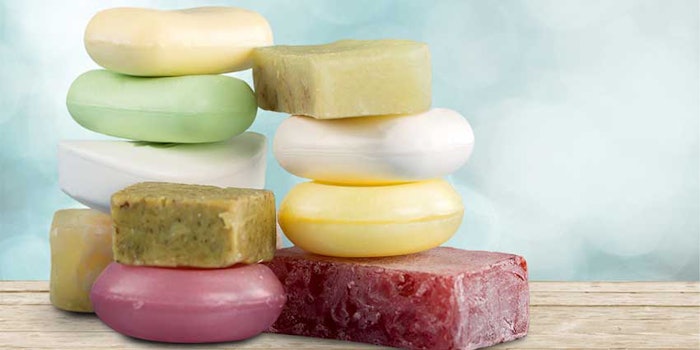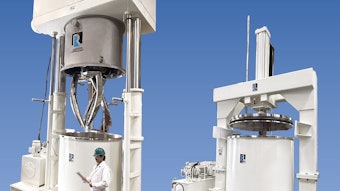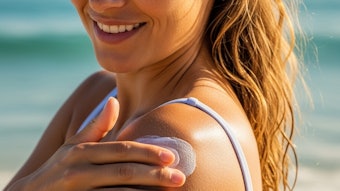
Bar soap manufacturing began in the late 19th century; however, historians have discovered a form of soap dating back as early as 2,800 B.C.1 While the technology for making bar soap has improved over the years, the process of making soap and formulas for solid bars has essentially remained the same and involves the conversion of fats such as tallow/coconut oil into soap in a process known as saponification. Saponification is a simple acid and base reaction in which triglycerides are reacted with a strong alkali such as sodium hydroxide to form soap and glycerin.
Today there are several modern processes to manufacture soap and glycerin. These processes include kettle saponification, continuous saponification and fatty acid neutralization. Regardless of which process is used, the final product consists of soap, glycerin and water. Some common characteristics of a solid bar soap include an alkaline pH and the formation of foam.
Bar soap historically has been used for cleansing, although various improvements over the years have enabled the addition of beneficial moisturizers, exfoliants and fragrances, as well as the creation of unique bar shapes and sizes and the development of translucent bars.
It is difficult to improve upon a technology that has withstood the test of time, much less consumers’ ingrained perceptions of bar soap. In order to achieve this, it would be necessary to change traditional bar soap from a cleansing-only product to a treatment product. In the present study, researchers describe how combining actives with a delivery technology that allows actives in the soap to remain on the skin, even after rinsing, can accomplish this.
Challenges
The challenge of working with soap is that many desired additives are not compatible with soap due to either the chemistry or the manufacturing process. For example, the high alkalinity or pH of the soap base will neutralize ingredients such as salicylic acid, hylauronic acid and alpha hydroxy acid. A delivery system that protects the additive from interacting with the soap base is needed. Encapsulation is one answer to the chemistry challenge but the extrusion process poses another barrier.
Today’s most efficient manufacturing processes for bar soaps use extrusion plodders. Extrusion plodders consist of a screw or worm that forces the soap formula through refining screens to blend formula ingredients together in the final product. The extrusion portion of the process is when the soap formula is forced through an extrusion plate in the shape of a mold that is then stamped to form the final shape.
During the extrusion process, excessive amounts of force and pressure are exerted on the soap mixture in order to homogenize the formula. Most existing encapsulation technologies cannot withstand the pressure and rupture, ultimately leaking their cargo into the soap formula. After years of research, Twincraft found an encapsulation technology capable of withstanding this pressure and recently developed a bar soap using this system in conjunction with its manufacturer, as the authors describe here.
The final challenge to developing a delivery system for bar soap is that the system needs to adhere to the skin and resist rinsing. To overcome this problem, positively charged polymers can be used that adhere well to the negatively charged surface of the skin. The charge density of the capsule is greater than that of bar soap and is therefore not neutralized by the soap’s negative charge.
The encapsulated materials also adhere to the surface of skin because of their size, which ranges from 100–150 nm.
Being larger than 10 nm, these materials are not considered nanotechnology. The company specifically designed the materials to be larger so as not to subject them to consumer concerns related to nanotechnology. This small particle size allows for the “wedging” of the capsules into the irregular surface of the outer epidermis.
Encapsulation Solution
As noted, to meet the challenges of producing a bar soap with treatment benefits, an encapsulated delivery system was required that would resist extrusion forces during manufacture but that would also remain soft enough to release the active onto skin. In conjunction with Salvona Technologies, Twincraft co-developed an encapsulated delivery systema that survives the extrusion process and adheres to skin. This system includes polymers derived from corn starch to encapsulate different actives such as salicylic acid, green tea, peptides, caffeine and conjugated linoleic acid, and produces consistent circular-shaped spheres that trap the active ingredient while protecting it from the soap environment (see Figure 1).
This system was built to be flexible so that the matrix can be modified in order to support different encapsulated ingredients; it also can be modified for use in lotions, deodorants, shampoos, liquid soaps and lip balms.
A universal limitation of bar soap is its inability to carry a high concentration of actives. However, this system was designed to carry a much higher load. And with a higher load capacity, the soap can carry more active. In turn, this makes treatment more effective. It also is cationic and thus is attracted to
the skin, while being small enough to travel through the outer layers of the epidermis, allowing for greater penetration of the active into the skin (see Figure 2).
The sphere’s uniform wall thickness and shape provide consistent, predictable release, which will be shown here, and are produced by consistent manufacturing controls. The capsules themselves can be made from either synthetic or natural polymers and their release of actives is triggered by water. The encapsulated material is designed to open after extended—i.e., 5 min to 120 min—exposure to water. This works by the water breaking the bond between the polymers, thereby releasing ingredients over time. There are two water sources acting in this way, the water used during bathing and moisture in the skin itself. The described delivery technology also is shown to increase the amount of active that stays on the skin over time. Typically, synthetic polymers are used in delivery system bars because of their lower price point as well as fewer restrictions on which ingredients can be encapsulated.
In regard to extended release, a key aspect to this delivery system is its dual-phase design. This means the “stage 1” encapsulated materials will hold both active ingredients and smaller encapsulates. These smaller encapsulates are released in “stage 2.” The result is the active ingredient being released over a prolonged period of time, or two different ingredients are released—one ingredient in stage 1 and a second, complementary ingredient in stage 2. For example, a stage 1 release of salicylic acid to exfoliate and unclog pores, followed by a stage 2 release of a sebum-controlling ingredient to reduce oil and prevent future acne.
Deposition Tests
A skin extraction experiment was designed to test the amount of active, in this case salicylic acid, remaining on the skin after rinsing. This procedure was developed because tape-stripping methods were found to produce contaminants that skewed the measurements taken by gas chromatograph. An alcohol solution was used to dissolve the encapsulated salicylic acid on the surface of the skin (see Figure 3).
Participants left the lather on their skin for 10 to 30 sec, typical use with personal care treatment products. Two different tests were performed: one analytical study to show skin deposition and one consumer test for efficacy. The bars in both the analytical and consumer study were approximately six months old. As an aside, the company continually tests the bars according to the U.S. Food and Drug Administration (FDA) over-the-counter protocol for 36 months. In all cases, the delivery system active ingredients remained stable with no change in concentration (data not shown). The solution was captured in a specialized funnel and transferred for HPLC analysis of the salicylic acid deposited on skin (see Figure 4).
The results indicated a 250% increase in initial deposition of the salicylic acid over a control. After 2 hr, the amount of salicylic acid deposited was over 400% more than without the delivery system (see Figure 5). The initial skin deposition without the delivery system was 12 ppm and with the delivery system it was 30 ppm. At 80 min, deposition without the delivery system measured 2 ppm and with delivery system measured 16 ppm-statistically an 800% greater deposition; however, since the ppm readings were extremely low on deposition without the delivery system at 80 min, the company has maintained a conservative position, claiming a 400% increase in efficacy. The authors note is possible that the actual ppm could have measured 0 or 4.
This significant increase in salicylic acid after 2 hr is due to the time release nature of the multi-release capsule utilized in the test. The multiple releases allow for the treatment of the skin over an extended period of time as well as treatment of skin by two different ingredients. Per Figure 5, the release occurs at approximately 70 min-the point at which capsules released additional salicylic acid.
Consumer Testing
An independent consumer study tested a bar soap incorporating salicylic acid either with the described delivery system or without it, in a placebo bar. During a 4-week test period, 39 participants including 34 females and 5 males, ranging in age from 15 to 51, used either a 0.5% salicylic acid soap bar with the delivery system, a 2.0% salicylic acid bar with the delivery system, or a placebo bar. At the start of the test period, participants were asked to count the total number of blemishes on their face. After the 4-week test period was completed, participants counted the number of blemishes again.
Results indicated that the bar incorporating the delivery system cut the number of blemishes in half by week 4; the 2% bar reduced acne by 67% in users with severe acne; and 70% of testers would recommend the bar incorporating the delivery system. This study was conducted using a 100% vegetable soap because, among other reasons, this limited the number of variables in the test procedure.
The alkaline nature of vegetable soap bases tends to neutralize free salicylic acid and convert it to salt; therefore, no salicylic acid is deposited on skin. However, because the salicylic acid is protected by the encapsulate, the researchers chose to test the performance of salicylic acid in a vegetable based bar using the delivery system.
Results of these consumer studies indicated that the delivery system provided effective treatment. This mirrored results found by the skin extraction studies, which measured deposition and not treatment. The salicylic acid was deposited on the skin and stayed on the skin, providing effective anti-acne treatment. Since the bar with the delivery system deposited 250% to 800% more active than a syndet with free salicylic acid, the bar with the delivery system was deemed highly effective. The FDA monograph clearly states that as the percentage of salicylic acid is increased, so too is the treatment. This was further reinforced in the consumer study, where the 2.0% bar outperformed the 0.5% bar in cases of severe acne.
Conclusion
Soap in either a vegetable, tallow or syndet base is a rinse off vehicle. Actives typically found in bar soap do not have a means to stay on the skin. Ingredients, like the lather that is generated, go down the drain. However, new delivery systems have made it possible to encapsulate a variety of actives such as salicylic acid in bar soap to provide positive benefits to skin. Besides salicylic acid, other actives such as green tea, peptides, caffeine, conjugated linoleic acid, skin brightening ingredients, sun protection and tanning, can be incorporated to provide various skin treatments. From antiaging to anti-acne, delivery systems have reinvented the function of bar soaps from basic cleansing to treatment products, opening a new window of opportunity to formulators.
References
1.Source: The Evolution of Clean by Luis Spitz










